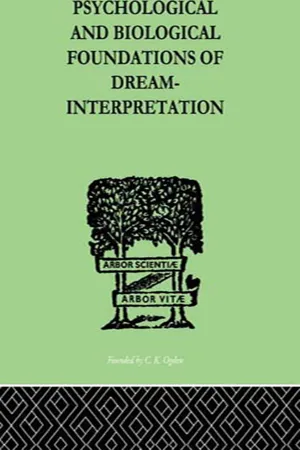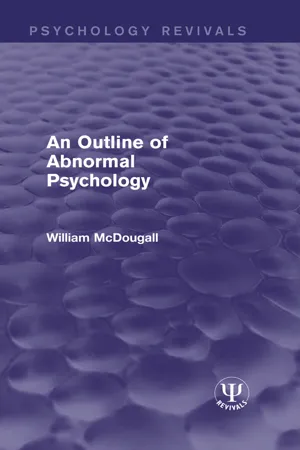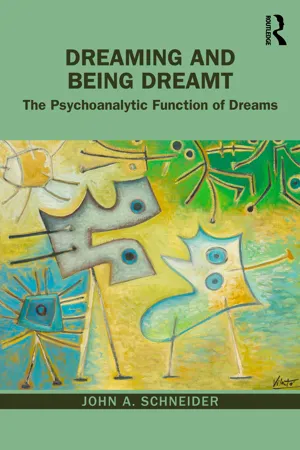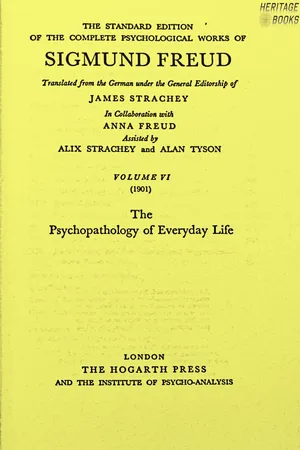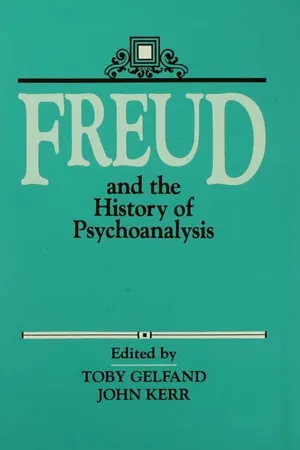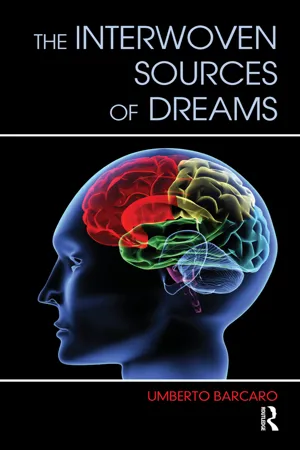Psychology
Freud's Theory of Dreaming
Freud's theory of dreaming posits that dreams are a manifestation of unconscious desires and conflicts. He believed that dreams provide a window into the unconscious mind, allowing repressed thoughts and emotions to surface in symbolic form. According to Freud, the interpretation of dreams can reveal hidden aspects of an individual's psyche and contribute to the understanding of psychological disorders.
Written by Perlego with AI-assistance
Related key terms
11 Key excerpts on "Freud's Theory of Dreaming"
- eBook - ePub
Therapy with Dreams and Nightmares
Theory, Research & Practice
- Delia Cushway, Robyn Sewell(Authors)
- 2012(Publication Date)
- SAGE Publications Ltd(Publisher)
The experience of working essentially from an integrationist perspective inevitably leads to looking for the similarities and contrasts between different theories. In following the dream theories over the last 25 years, it is interesting to see how the various models and theories have developed from each other. Much contemporary writing has been based on the work and concepts of Carl Jung, even though much of the groundwork for Jung’s theories was laid by Freud. At this stage it is helpful to discuss some of the main theories and models that have been influential in shaping contemporary dreamwork.Freud’s theory of dreams
Freud saw dreams as the ‘royal road to the unconscious’, where the memories, desires or impulses that were unacceptable to the conscious waking mind were repressed or buried. He understood dreams as largely the product of this unconscious mind and believed that one function of the dream is to preserve sleep by resolving these buried impulses or desires that would otherwise disturb sleep. By examining his own dreams, as well as those of his patients, Freud came to consider that repressed wishes in the unconscious mind found substitute gratification during sleep in the form of dreams. Thus he believed that the dream is a kind of neurotic symptom in its own right. Often, then, the dream reflects the fulfilment of an unsatisfied wish. Freud gave the example of a small boy who dreams of eating a basket of cherries which he was not allowed to eat the day before. In this case the simple, direct wish fulfilment is obvious from the story or ‘manifest content’ of the dream. However, Freud believed that as people grow older many of the wishes and desires that are associated with earlier stages of development are unable to be fulfilled in reality and so become repressed and generally inaccessible to our conscious mind. He believed that these desires could find fulfilment in the form of a dream but also thought that they would cause us to awaken in intense anxiety, and so he believed that they were disguised. Therefore the dream imagery might symbolize a hidden, or disguised, meaning, which Freud called the ‘latent content’ of the dream. For example, in an older person the boy eating a basket of cherries might have represented a latent unfulfilled oedipal wish of a boy wishing to possess his mother sexually. The disguise function of dreams not only allows the dreamer to discharge forbidden wishes, but also allows the dreamer to sleep undisturbed by concealing the nature of the wish. Freud saw the dream as functioning both as a guardian of sleep and as a safety valve for unacceptable wishes. - eBook - ePub
Freud: The Key Ideas
Psychoanalysis, dreams, the unconscious and more
- Ruth Snowden(Author)
- 2017(Publication Date)
- Teach Yourself(Publisher)
Modern psychologists have had a tendency, until recently, to see dreams merely as a kind of information processing – perhaps assimilating ideas about what has happened in waking life and then incorporating this information into memory banks. But dreams can certainly help us to solve ongoing problems, so there was a lot of truth in Freud’s ideas. Recent research has suggested that the areas of the brain which control emotion and motivation are frequently aroused during REM (rapid eye movement) sleep – the phase of sleep when most dreaming occurs – so maybe Freud was not far off the mark. Dreams, as many writers will agree, also unleash creative processes – so the unconscious is not all about repressed and negative impulses as Freud tended to insist. However, the important thing is to recognize that it was Freud who played the biggest part in starting the process that led to the evolution of modern theories about the dreaming mind. For him, the dream is all-important, ‘one of the really deep and formative experiences of our soul’, and so it forms one of the cornerstones of the psychoanalytic process.Focus points✽ Dreams are of central importance in psychoanalysis.✽ Freud saw dreams as wish fulfilments.✽ He said that each dream has both a manifest and a latent content.✽ He identified special mechanisms that prevented the latent content from becoming conscious.✽ Freud believed that much of a dream’s content was disguised by means of symbols.✽ Freud interpreted dreams mainly in two ways – the symbolic method, which explores symbolic meaning, and the decoding method, which uses traditional interpretations.✽ He maintained that most dreams harked back to childhood experiences, particularly sexual ones.Next stepThe next chapter looks at one of the most enduring parts of Freud’s thought: his ideas about the structure and functioning of the human mind. For Freud, these ‘layers’ or ‘spaces’ of the human mind were a useful way to explore and understand the tensions and conflicts that caused human anxiety and unhappiness. - eBook - ePub
Sleep Disorders
Elements, History, Treatments, and Research
- Kathleen J. Sexton-Radek Ph.D., Gina Graci(Authors)
- 2021(Publication Date)
- Praeger(Publisher)
CHAPTER 10 Dreaming as a Psychological ProcessW hy do we dream, why are some dreams frightening, and why do we only remember some of our dreams? Hypotheses have abounded for years regarding the meaning and biological or neurological pathway of dreams. Some people earn a living by analyzing dreams, but what do dreams really mean, and what is the current dream landscape? The symbolic meaning of dreams is called the latent content of dreams, and many people believe there are hidden messages in dreams. Some scientists believe that dreaming is related to depression, and some therapists postulate that if the unconscious meaning of dreams can be interpreted, then psychological distress could be relieved (Cherry, 2020). This chapter will explore dreaming as a psychological process.A dream is defined as a physiologically and psychologically conscious state that occurs during sleep. It is often characterized by a rich array of endogenous sensory, motor, emotional, and other experiences (American Psychological Association [APA], 2020). Dreams mainly occur in rapid eye movement (REM) sleep and may be logical or illogical. Dream interpretation is the attempt at finding meaning from dreams as it applies to an individual’s life.Sigmund Freud believed that the meaning and content of dreams were heavily encrypted and hard to translate (Lyon, 1990). The hidden meaning of dreams played an important role in Freud’s psychoanalytic theory, and he believed that bringing the hidden meaning of a dream into conscious awareness could relieve psychological distress (Freud, 1913). For instance, Freud believed that the latent content of a dream was not only suppressed but hidden by the subconscious mind to protect the person from thoughts and feelings that were hard to cope with (Cherry, 2020).While the function of sleep is hypothezied to be based on restorative properties, there is no concluding evidence that this is true. The early work of Dr. Rosalind Cartwright (the Grandmother of Sleep) showed the scientific measurement of sleep and dreaming, primarily dreams and the process of dreaming. “Dreams,” wrote Cartwright, “are our private perceptions which cannot be validated or shared by others” (Cartwright, 1977). She also postulated that dreams may “provide us with a direct cure for certain mental problems long before anyone determines exactly what sleep and dreaming are for” (Lyon, 1990). - Samuel Lowy(Author)
- 2013(Publication Date)
- Routledge(Publisher)
CHAPTER VIFREUD’S THEORY OF DREAMS
(I) IN this chapter we shall try to give a brief but precise account of Freud’s theory of dreams, which has been the foundation of all advances in this field. Even to-day, the great number of his closer followers look upon it as the only valid theory, sufficient in its every detail. Freud distinguishes (I) the manifest dream, i.e., the remembered, verbalised description of the dream ; (2) the latent dream-thoughts, i.e., the supplements to, and sources of, the various parts of the dream, brought to light by means of free association and interpretation ; (3) the actual dream stimulus. This last factor is always a wish-tendency. As one can see from a careful scrutiny of Freud’s writings, it is an unconscious wish ; an instinctive drive, originating in infantile sexuality, which has suffered repression, but which has always remained active. This drive supplies the energy which combines with various thoughts, memories, etc., and constructs the manifest dream. The elements are transformed symbolically to varying degrees. One of these elements called the “day-residue ”, is a recent memory from the day be.fore the dream. “The pressure of the unconscious wish on the day-residue creates an additional part of latent dream-thoughts ” (Introductory Lectures);in other words, the latter become connected with the former energetically charged element. The whole formation is a hallucinatory experience whose psychic value lies in the satisfaction of the latent wish. The wish-fulfilment, as the final result from the subjective point of view of the dreamer, would thus represent the fourth factor of this dream-theory. In Freud’s larger work on dreams he constantly emphasises, however, that the wish which is becoming fulfilled in the dream, is not always a sexual one, and that the dream also fulfils other wishes of the dreamer. But in the final analysis of his writings it remains true that for Freud the fundamental cause of adult dreaming is infantile sexuality, which combines with elements of a different kind, and so, too, with different wishes of recent actuality. That particular agency which initiated the original repression and which maintains it by means of a “ counter-cathexis ”, is responsible also for the disguising of the wish-fulfilment, effectuated by the dream-work. Indeed, it is only the weakening of this “ censor ” during sleep, which makes it possible for the infantile wish to become sufficiently active, to stimulate dreaming, and to construct the dream-image by means of the latent thoughts. Freud calls the retreat into sleep a regression (to the infantile or even to the pre-natal). The re-animation of the infantile wishes in sleep is a consequence of this regression, or rather one aspect of it. Freud regards also the representation through symbols and visual images as regressive ; first he reduces the symbols to archaic modes of speaking and thinking (phylogenetic regression) ; further he believes that certain logical operations of the mind,such as causal relations, judgments, identifications, etc., can be expressed by the dream-ego only in a primitive way, i.e., by juxtaposition and succession of individual images.“ After the manner of a primitive language only the raw material is expressed, abstract notions are reduced to their concrete foundations. . . . The representation of certain objects and events by means of symbols, which have become foreign to the conscious way of thinking corresponds both to the archaic regression of the psychic apparatus, and to the requirements of the dream-censor.” (New Introductory Lectures- eBook - ePub
- William McDougall(Author)
- 2015(Publication Date)
- Routledge(Publisher)
Thirdly, the dream, being a thinking of more primitive type than waking thinking, proceeds largely in imagery, and this naturally involves an allegorical and symbolical use of images. Fourthly, some dreams are expressions of repressed sexual desires, and some dream symbols are sexual. Fifthly, some of the other processes described by Freud as characteristic dream processes do occur in dreams. Some of these were illustrated in the foregoing chapters, e. g., the tendency to punning and play upon words, and the process of condensation, by which one dream object is made to stand for two or more objects, or is a composite formation showing traits of two or more objects or persons. I recognise, then, that there is much that is true in Freud’s theory of dreaming, and that Professor Freud must be recognised as the man who has opened the way to an understanding of dreams. But, so much being admitted, there remain very strong grounds for rejecting those features of Freud’s theory which may fairly be called the characteristically Freudian features, especially the assertion that all or the vast majority of dreams that are not simple direct expressions of bodily needs can be traced back to infantile desires or fixations; as also the assertion that the great majority express sexual desires. Objections to Freud’s Dream Theory Let me state these grounds as concisely as possible. First, the notion that “the Unconscious” (or its repressed tendencies) can and does attain pleasure or satisfaction through escaping the vigilance of the Censor and finding disguised expression in the manifest dream-content is fantastic, obscure, and very difficult to accept. This seems to me an error bound up with the unfortunate and uncritical acceptance by Freud of the “pleasure principle,” the principle of psychological hedonism - eBook - ePub
Dreaming and Being Dreamt
The Psychoanalytic Function of Dreams
- John A. Schneider(Author)
- 2023(Publication Date)
- Routledge(Publisher)
The state of sleep does not wish to know anything of the external world; it takes no interest in reality, or only so far as abandoning the state of sleep – waking up – is concerned . . . all the essential characteristics of dreams are determined by the conditioning factor of sleep.(Freud, 1915/1957 , p. 234)Dreams, as “guardians of sleep,” serve the psychological function of keeping sleep from being overwhelmed by disturbing thoughts. If repressed infantile wishes exert pressure for access to thinking and are uncensored or poorly disguised, they enter the preconscious in a form that is so disturbing as to wake the person up.Freud does not believe that by dreaming the dreamer does psychological work that helps deal with unsettling emotional experience; rather, he believes that dreaming dissipates the threat of overwhelming anxiety caused by the tension of repressed sexual impulses originating in childhood. This view suggests that human emotional development is driven by instincts (experienced as sexual impulses and their derivatives) and that the taming of sexual tension and expression is the primary developmental force.Freud believed that we dream only in sleep when the freedom of visual representation that comes with diminished censorship and a state of disconnection of the mind from voluntary musculature allow derivatives of the repressed to appear in dreams. The dream safeguards sleep by acting as a safety valve, allowing sleep to continue by letting off just enough tension from unconscious drives. If too much libidinal or aggressive energy is released, the capacity for symbol formation through dreaming is exceeded. When unconscious tension builds to such intensity, it wakes the person up. Pressure is transferred from one part of the mind to the other, but the underlying emotional tension continues to exist unless and until the analyst makes an interpretation that helps to resolve the unconscious conflict to which it has given rise. The work being done during dreaming alone is limited to monitoring and regulating the “return of the repressed.” 3 - eBook - ePub
- W H R Rivers(Author)
- 2013(Publication Date)
- Routledge(Publisher)
In accordance with the spirit of that time the solution expected and given was of a prophetic kind. Dreams were regarded as means of foretelling the future, and this view is not only still widely held in popular belief, but it shows its influence also in the great importance attached to what is called the prospective value of the dream by one of the two chief schools of scientific dream-interpretation at the present time.It is only during the last twenty years that we have made any real advance in the scientific study of the subject. Until still more recent times psychologists in general have paid but little attention to dreams.When I suggested a question on dreams in a University examination not many years ago, it was objected that the students would know nothing about the subject, which meant, of course, that they had been taught nothing about it. The consideration of the psychology of dreams was not deemed worthy of inclusion in a course of academic psychology.The great revolution in the attitude of psychologists which has since occurred is due to Freud—I think one might say entirely due to him. Among the many aspects of the vast influence which Freud has exerted upon psychology, none is more prominent than that concerned with dreams and their interpretation, It is natural, therefore, that I should make his work the starting-point of this discussion, and that a considerable part of the book will deal with criticism of his views.I am very far from accepting everything that Freud has taught about the psychology of dreams, and I hope in this book to do my best to make clear where, in my opinion, his views should be accepted; where we must refuse to follow him; and where our treatment, though running near his, should nevertheless diverge from it somewhat, either in its course or in its ultimate goal.The first great contribution made by Freud to our understanding of the dream is his distinction between the manifest and the latent content. The older interpreters were chiefly interested in the incidents of the dream as actually experienced. If they dreamt of a death or a birth they were content if they were able to discover that on the previous day, or at some earlier time, they had seen a funeral or had heard of an addition to the family of an acquaintance. They gave no explanation of the irrational and fantastic character of the dream, nor did such explanation seem to them necessary. They were content to regard this character as proper to the dream and as no more in need of explanation than the imaginative character of poetry or the mournful nature of a tragedy. Even now there are prominent “scientific” writers who believe that they have provided a sufficient explanation of a dream when they have been able to refer its incidents to associations arising out of waking experience. - eBook - ePub
- Sigmund Freud(Author)
- 2019(Publication Date)
- Heritage Books(Publisher)
First of all, Freud pointed out a constant connection between some part of every dream and some detail of the dreamer's life during the previous waking state. This positively establishes a relation between sleeping states and waking states and disposes of the widely prevalent view that dreams are purely nonsensical phenomena coming from nowhere and leading nowhere.Secondly, Freud, after studying the dreamer's life and modes of thought, after noting down all his mannerisms and the apparently insignificant details of his conduct which reveal his secret thoughts, came to the conclusion that there was in every dream the attempted or successful gratification of some wish, conscious or unconscious.Thirdly, he proved that many of our dream visions are symbolical, which causes us to consider them as absurd and unintelligible; the universality of those symbols, however, makes them very transparent to the trained observer.Fourthly, Freud showed that sexual desires play an enormous part in our unconscious, a part which puritanical hypocrisy has always tried to minimize, if not to ignore entirely. Finally, Freud established a direct connection between dreams and insanity, between the symbolic visions of our sleep and the symbolic actions of the mentally deranged.There were, of course, many other observations which Freud made while dissecting the dreams of his patients, but not all of them present as much interest as the foregoing nor were they as revolutionary or likely to wield as much influence on modern psychiatry.Other explorers have struck the path blazed by Freud and leading into man's unconscious. Jung of Zurich, Adler of Vienna and Kempf of Washington, D.C., have made to the study of the unconscious, contributions which have brought that study into fields which Freud himself never dreamt of invading. - eBook - ePub
- Toby Gelfand, John Kerr, Toby Gelfand, John Kerr(Authors)
- 2013(Publication Date)
- Routledge(Publisher)
7Two Major Difficulties for Freud's Theory of Dreams *
Adolf GrünbaumB efore 1920, Freud's wish-fulfillment theory of dreams asserted two universal major theses, which he encapsulated in the following conjunction: The manifest dream “content was the fulfillment of a wish [first thesis], and its motive was a wish” [second thesis] (Freud, 1900, p. 119). As Freud recognized, neither of these two theses is redundant with the other. But in his “Revision of the Theory of Dreams” (Freud, 1933), he did explicitly retract the first claim that the manifest dream-content universally displays the fulfillment of a wish though in a more or less defensively disguised form (pp. 28-30). On the other hand, there he continued to uphold his second thesis that the dream-motive is always a wish, rather than, say, a fear. And, moreover, that wish was purportedly always, at bottom, a repressed infantile one. But in his earlier 1920 revision in “Beyond the Pleasure Principle,” he had even retracted this second thesis in favor of the notion that the so-called compulsion to repeat, rather than a wish, was the motive of dreams that reenact traumatic experiences.As we know, the evidence Freud offered for his theory of dreaming depended crucially on his method of free association. But I have argued (Grünbaum, 1984) that Freud's celebrated Irma Dream completely failed to vindicate free association as a method of reliably fathoming dream motives. As I pointed out, Freud (1900) simply had no warrant for making the following major investigative assumption: if we associate to a given manifest dream element, then the emerging associations recapitulate in inverse temporal order the original unconscious dream thoughts, such that at least the great bulk of these thoughts were causally relevant - eBook - ePub
- Umberto Barcaro(Author)
- 2018(Publication Date)
- Routledge(Publisher)
Comparing the Freudian Theory with the approaches presented in the two books published in 1993, and introducing a certain simplification, we could say that, while Freud first of all looks at the “remote past”, the 1993 authors look at the present or at the “near past”. Another important difference, which is however conceptually connected to the difference between the two kinds of past, is that the 1993 authors do not share the emphasis put by Freud on the differences between the manifest dream and the latent thoughts. Freud feels that the meaning of a dream is concealed by the manifest dream, and underlines deformation as a major function of the dream-work. On the contrary, the 1993 authors tend to underline the capacity of a dream to reveal, to uncover its meaning in a clear, efficacious, and helpful way. This point of view is certainly connected to the diffusion of the Jungian approach to dream interpretation, which we shortly reviewed in Section [Some useful concepts taken from clinical theories of dreams different from Freud’s (14)]: in opposition to Freud, Jung insisted on the expressive and revelatory power of dream symbols.A summary of the 1993 book New Directions in Dream Interpretation
We feel that it could be useful to provide a short summary of the different approaches presented in the above quoted book New Directions in Dream Interpretation (Delaney, 1993a). Some of these approaches will be considered again later for the purposes of our reflections on the patterns of dream sources.The first contribution is the one by Ullman, who developed a method for working with dreams in groups. His approach starts from the recognition of a paradox. In the dream, the dreamer has created a personal and intimate representation of his or her inner life. At the same time, the dream expresses a need for help, and in order to receive help the dreamer must turn to other people, must go public in order to fully understand the information conveyed by the dream experience. In other words, a private experience must be transformed into a public communication.The second author of the book is Natterson, a psychotherapist who, starting from the Freudian point of view, has accepted the new elements introduced by contemporary therapists. He defines his approach as an evolution from a Freudian origin into an “intersubjective orientation”: the understanding of a dream in psychotherapy is the result of a “dialogue” between the patient and the therapist. His approach has therefore numerous elements in common with those of other authors, but he stresses the ideas of dialogue and subjectivity. - eBook - ePub
- Erich Fromm(Author)
- 2013(Publication Date)
- Open Road Media(Publisher)
For Freud, almost all symbols were accidental ones, with the one exception of sexual symbols; a tower or a stick is a symbol of male sexuality, and a house or the ocean, a symbol of female sexuality. In contrast to Jung, who thought all dreams are written in a clear and uncoded text, Freud thought exactly the opposite, that almost no dream could be understood without being decoded.From my experience of interpreting many people’s dreams, including my own, I believe that Freud, by dogmatic generalization, restricted the significance of his discovery of the censorship operating in a dream. There are many dreams in which the censorship consists of nothing but the poetic and symbolic language in which the content is expressed, but this is a “censorship” only for people with little poetic imagination. For those with a natural sense of poetry, the symbolic nature of the dream language can hardly be explained as censorship.In the following I quote a dream (see Fromm, 1951a, chapter 6) which can be understood even without any association and where there are no elements of censorship. On the other hand, we can see that the associations brought up by the dreamer enrich our understanding of the dream:A lawyer, twenty-eight years of age, wakes up and remembers the following dream which he later reports to the analyst: “I saw myself riding on a white charger, reviewing a large number of soldiers. They all cheered me wildly.”The first question the analyst asks his patient is rather general: “What comes to mind?” “Nothing,” the man answers. “The dream is silly. You know that I dislike war and armies, that I certainly would not want to be a general.” And in addition, “I also would not like to be the center of attention and to be stared at, cheering or no cheering, by thousands of soldiers. You know from what I told you about my professional problems how difficult it is for me even to plead a case in court with everybody looking at me.”The analyst answers: “Yes, but it does not do away with the fact that this is your dream, the plot you
Index pages curate the most relevant extracts from our library of academic textbooks. They’ve been created using an in-house natural language model (NLM), each adding context and meaning to key research topics.



